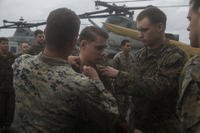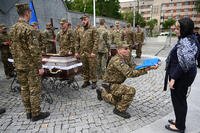Change is afoot in the Army: Divisions are returning to prominence.
From recent reporting to rumors and offhand comments made during briefings, an image is beginning to emerge of the Army of the future. Bursting with enablers and officers, full general staffs, additional brigade and battalion headquarters with more staff, and funding, the divisional headquarters may soon replace brigade headquarters as a unit's heart.
That would mark a big change from the past 20 years. During much of the Global War on Terror, or GWOT, the action downrange in combat and at home in garrison was at the brigade combat team, or BCT, level. For the overwhelming majority of veterans in Iraq and Afghanistan, "division" was a combat patch, a notional way of organizing brigades.
Read Next: Alabama Lawmaker Blocks Pentagon Budget Moves to Force Decision on Space Command Basing
"The BCT model worked really well during GWOT," according to a retired brigadier general with experience at the brigade and division level who agreed to an interview on the condition that his name not be used. "In that fight, most of the tactical challenges could be dealt with by a rifle company. The Army fights two levels down; two levels up from the company level is the brigade."
In a literal sense, divisions never left. While at garrison, the division was the origin of daily or weekly operations orders and taskings for troops. Downrange in Iraq or Afghanistan, the division coordinated the distribution of assets such as helicopters, aircraft and artillery -- but was unseen by soldiers patrolling from smaller company- or platoon-level forward operating bases, or FOBs.
But the importance of divisions waned in the beginning of GWOT. Assets were pushed down to BCTs. A thriving culture (or bureaucratic hassle, depending on one's perspective) vanished with the flourish of a pen, never to return. Until now.
The restructuring originated in the 1990s when, after the Cold War, some Army planners saw smaller conflicts and insurgencies of the type later encountered in Iraq and Afghanistan as the future of conflict (others did not). Drawing on feedback from officers and data pulled from exercises, leadership decided on a dramatic overhaul of force structure.
Between 2003 and 2004, as brigades were standardized or made "modular," assets that had existed mostly at divisions since their creation -- a signals battalion; military intelligence battalion; artillery brigade; and a brigade full of support and logistics, so-called "enabler" units -- were sent to brigades in company- or battalion-sized elements.
This gave brigades the resources they needed during GWOT to function autonomously. It also helped forge teamwork and relationships in training and garrison that translated to more effectiveness downrange in combat. The reorganization also eliminated unnecessary battalion and brigade staff positions, freeing up force structure spaces for combat soldiers, sergeants and officers.
One factor complicating the shift is that most people who experienced both models and were in a position to compare are no longer in the military. This uncertainty is helping fuel a debate now over how much power to keep at Army brigades -- or whether to move it all back to the division level.
Some worry that bringing the units back from the brigade to division level risks losing lethality at the point where it is most needed on the battlefield -- that it will be adding potentially redundant layers of bureaucracy that will slow decision-making, decrease flexibility, degrade unit flexibility and trust, and reduce interoperability.
"Our first-order principle for how to organize the Army is that we should optimize our force structure for warfighting," retired Gen. Robert "Abe" Abrams said in an interview.
Abrams commanded a pre-modularity brigade combat team in Iraq during Operation Iraqi Freedom II and later a division with several modular BCTs underneath it in combat in Afghanistan, and feels that the Army got the BCT exactly right.
"At present, the BCTs are optimized for lethality," he said. "Take assets from the BCT commander, you're losing some of that fighting capability."
Abrams stressed that the advantages gained through training, in shared language through habitual associations, and with relationship-building collectively outweigh the benefits of keeping those assets at a higher level.
"We risk taking a step back as a force if we back away from the BCT model that's proven itself so effective at fighting together as a team," Abrams said.
Though most agree losing the BCT's combat capabilities would be a mistake, others see the move to re-emphasize divisions -- and possibly even corps -- as inevitable and necessary for planning and command.
"In a fight, it can be difficult for a brigade commander to know what's around them," retired Maj. Gen. Fred "Doug" Robinson said.
Robinson said that combined arms warfare has always been difficult to manage, and that the complexity of war is only growing with technological advances in weapons such as drones and cyber warfare.
"At the most, you've got 24 to 48 hours of space in which to plan and think in a peer-to-peer fight," he said. "There just aren't enough hours in the day. Properly staffed, divisions can help plan and make those decisions. It opens up planning for days rather than hours."
Retired Maj. Gen. William "Bill" Nash commanded a brigade during Desert Storm that was similarly organized to one of the more recent modular BCTs. He later commanded the 1st Armored Division in Germany, from which it deployed to Bosnia in 1995.
"A division is more than a major general," Nash said during an interview. "It's an ex-brigade commander, chief of staff, a dozen lieutenant colonels who've graduated from Leavenworth and probably one or more War College graduates. It's people with brigade and battalion command and staff experience, who can write sensible orders and coordinate effectively."
Nash, like Abrams, said he hopes the transition to divisions with fuller staffs keeps brigades powerful.
As a strong believer in habitual associations and the importance of units training together and knowing one another's strengths and weaknesses, Nash said the division he led in Bosnia was at its best just after it redeployed, and that the combination of real-world experience and training helped form one of the strongest units he'd ever seen.
"Having the division structure in addition to a strong brigade component is nothing but advantage," he said.
Meanwhile, the Army's recent struggles with recruiting are putting planners in a tough position.
"Restructuring the force is a zero-sum game," said Abrams. "Ideally, you'd have all the personnel and equipment you want. To do everything correctly you'd need to expand, and that would take well over half-a-million people. We're 30,000 short of the 485,000 authorized to man the force we have now."
And that means strengthening divisions could come at the expense of brigade power -- something nobody wants to see happen.
If recruiting continues to pose a challenge, the retired brigadier general who wished to remain anonymous feels that technology may make up some ground, by helping ensure the right people get to the right positions.
"We're developing our understanding of people and their personalities," he said. "With the right tools, we can maximize the use of the people we have. One way or another, though, we'll get it done."
-- Adrian Bonenberger, an Army veteran and graduate of the Columbia University Graduate School of Journalism, reports for Military.com.
Related: Cutting Weight: Marine Infantry Battalions to Shrink 10% by End of the Summer











